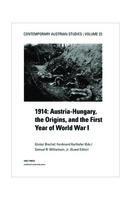1914: Austria-Hungary, the Origins, and the First Year of World War I
| dc.contributor.author | Bischof, Günter | |
| dc.contributor.author | Karlhofe, Ferdinand | |
| dc.contributor.author | Williamson Jr., R. Samuel | |
| dc.date.accessioned | 2014-07-13 00:00:00 | |
| dc.date.accessioned | 2020-04-01T14:42:02Z | |
| dc.date.available | 2020-04-01T14:42:02Z | |
| dc.date.issued | 2014 | |
| dc.identifier | 483305 | |
| dc.identifier | OCN: 898086116 | en_US |
| dc.identifier.uri | http://library.oapen.org/handle/20.500.12657/33383 | |
| dc.description.abstract | For the past 100 years some of the greatest historians and political scientists of the twentieth century have picked apart, analyzed and reinterpreted this sequence of events taking place within a single month in July/early August 1914. The four years of fighting during World War I destroyed the international system put into place at the Congress of Vienna in 1814/15 and led to the dissolution of some of the great old empires of Europe (Austrian-Hungarian, Ottoman, Russian). The 100th anniversary of the assassination of the Austrian successor to the throne Archduke Francis Ferdinand and his wife Sophie in Sarajevo unleashed the series of events that unleashed World War I. The assassination in Sarajevo, the spark that set asunder the European powder keg, has been the focus of a veritable blizzard of commemorations, scholarly conferences and a new avalanche of publications dealing with this signal historical event that changed the world. Contemporary Austrian Studies would not miss the opportunity to make its contribution to these scholarly discourses by focusing on reassessing the Dual Monarchy’s crucial role in the outbreak and the first year of the war, the military experience in the trenches, and the chaos on the homefront. | |
| dc.language | English | |
| dc.relation.ispartofseries | Contemporary Austrian Studies | |
| dc.subject.classification | thema EDItEUR::N History and Archaeology::NH History | en_US |
| dc.subject.classification | thema EDItEUR::N History and Archaeology::NH History::NHB General and world history | en_US |
| dc.subject.classification | thema EDItEUR::N History and Archaeology | en_US |
| dc.subject.classification | thema EDItEUR::3 Time period qualifiers::3M c 1500 onwards to present day::3MP 20th century, c 1900 to c 1999 | en_US |
| dc.subject.classification | thema EDItEUR::N History and Archaeology::NH History::NHT History: specific events and topics | en_US |
| dc.subject.classification | thema EDItEUR::N History and Archaeology::NH History::NHW Military history::NHWR Specific wars and campaigns::NHWR5 First World War | en_US |
| dc.subject.classification | thema EDItEUR::3 Time period qualifiers::3M c 1500 onwards to present day::3MP 20th century, c 1900 to c 1999::3MPB Early 20th century c 1900 to c 1950::3MPBF c 1910 to c 1919::3MPBFB c 1914 to c 1918 (World War One period) | en_US |
| dc.subject.other | world war i | |
| dc.subject.other | austro-hungarian monarchy | |
| dc.subject.other | österreich-ungarn | |
| dc.subject.other | austria-hungary | |
| dc.subject.other | habsburgermonarchie | |
| dc.subject.other | 1. weltkrieg | |
| dc.subject.other | Prisoner of war | |
| dc.subject.other | Vienna | |
| dc.title | 1914: Austria-Hungary, the Origins, and the First Year of World War I | |
| dc.type | book | |
| oapen.abstract.otherlanguage | In den vergangenen 100 Jahren haben bekannte Historiker und Politikwissenschaftler immer wieder die Ereignisse des Juli und August 1914 analysiert und interpretiert. Die vier Jahre andauernden Kämpfe des 1. Weltkrieges haben das internationale System, das am Wiener Kongress 1814/15 seinen Anfang nahm, zerstört und zum Zerfall großer Reiche (Österreich-Ungarn, Russland, Osmanisches Reich) geführt. Der 100. Jahrestag der Ermordung des österreichischen Thronfolgers Erzherzog Franz Ferdinand und seiner Frau Sophie in Sarajevo ist nun Anlass, in Form von Gedenkveranstaltungen und Publikationen jener Ereignisse zu gedenken, die den zündenden Funken ins Pulverfass geworfen haben. Band 23 der Contemporary Austrian Studies versucht dazu einen Beitrag zu leisten, in dem die entscheidende Rolle der Doppelmonarchie zum Ausbruch des 1. Weltkrieges, die militärischen Erfahrungen in den Schützengräben und das Chaos an der Heimatfront beleuchtet werden. | |
| oapen.identifier.doi | 10.26530/OAPEN_483305 | |
| oapen.relation.isPublishedBy | 7e4aa047-ebd5-4269-b6c8-a86925324b93 | |
| oapen.collection | AG Universitätsverlage | |
| oapen.series.number | 23 | |
| oapen.pages | 400 | |
| oapen.remark.public | Relevant Wikipedia pages: Austria-Hungary - https://en.wikipedia.org/wiki/Austria-Hungary; Habsburg Monarchy - https://en.wikipedia.org/wiki/Habsburg_Monarchy; Prisoner of war - https://en.wikipedia.org/wiki/Prisoner_of_war; Vienna - https://en.wikipedia.org/wiki/Vienna |

